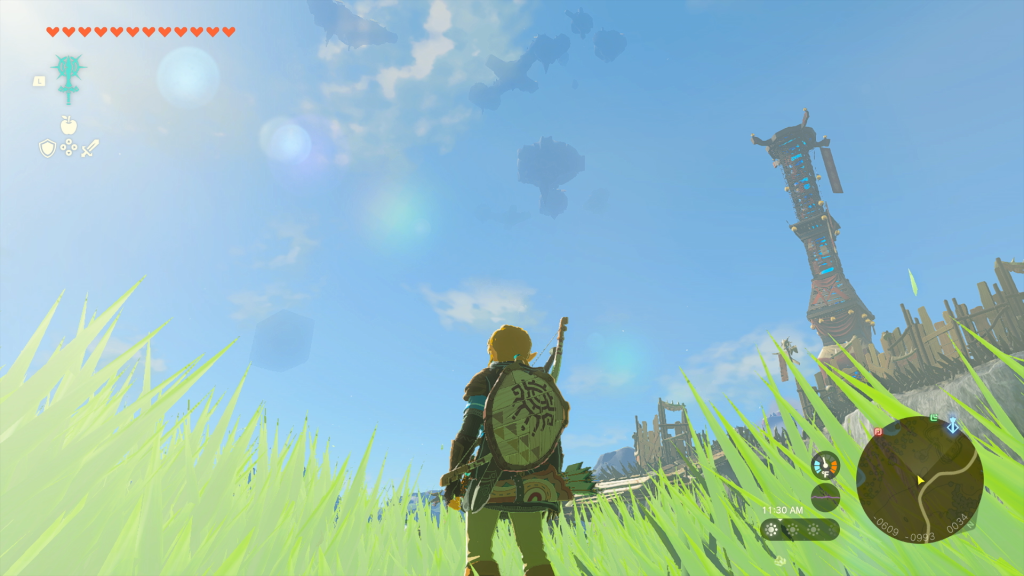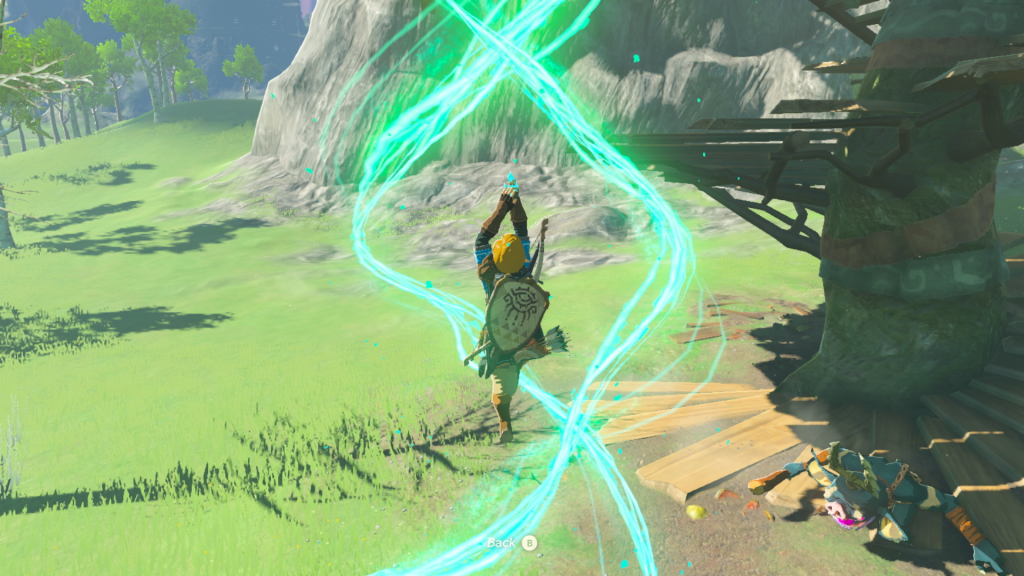There haven’t been a lot of direct sequels in the Zelda franchise. Since the days of the NES, Nintendo has typically opted to give each major game its own versions of Link and Zelda, in their own distinct section of the timeline. There have been exceptions, of course. Majora’s Mask, for example, built on the ending of Ocarina of Time while adding a bunch of new mechanics that still gave the game it’s own tone and feel. Last week, I had the privilege of playing The Legend of Zelda: Tears of the Kingdom at a special preview event held by Nintendo. My big concern going into the game was that it would feel like DLC for Breath of the Wild, as opposed to a unique title that stands apart from the previous game. After spending a little hands-on time with Tears of the Kingdom, it feels like those fears have been put to rest.
Videos by ComicBook.com
During our demo, we were thrown into a point midway through the game, after Link had already gained access to a number of new abilities. Unfortunately, that means I did not get to learn anything about Link’s new quest, the return of Ganondorf, or if this all might have a connection to Skyward Sword. Those major questions will have to wait until the game’s release. Instead, our preview event focused on the game’s new mechanics, and the ways players will use them to explore Hyrule and take down enemies.

One of the greatest strengths of Breath of the Wild is that it gave players the freedom to decide how they want to tackle the game. From the amount of time I got to play the game, Tears of the Kingdom already feels like a massive extension of that concept.
Link’s biggest new ability in Tears of the Kingdom is the Ultra Hand.Ultra Hand allows Link to grab various items in the game and pull themtowards him, or move them around the world. If it sounds similar toMagnesis in Breath of the Wild, that’s because the ideas aresimilar, but the concept has been fleshed out quite a bit. Now, Link cangrab pretty much any inanimate object (living creatures areoff-limits), and rotate them, which he can use to solve environmentalpuzzles. He can also use Ultra Hand to attach different objectstogether, which is showcased in the game via a green-colored goo.

For example, Link can use Ultra Hand to bring logs together and then attach them to make a raft. Items don’t just lock into a specific place once they’ve been lined up, though; they’ll adhere together in the exact spot you placed them, and that can have a drastic impact on the effectiveness of your creations. Thankfully, a quick shake of the “R” stick will separate the objects if you need a do-over.
The game also introduces new items called Zonai Devices. These single-use technological devices each have their own distinct abilities. For example, the Zonai Portable Pot allows Link to cook anywhere, without having to find a station. Some of these devices, like the Zonai Fan, draw from a new battery life gauge, which is displayed for players in a manner similar to Link’s stamina.

At one point in the demo, Link had to cross a big gulf. Luckily, therewas an old mine cart and some tracks nearby. After grabbing the cart andmoving it to the tracks, I could attach a Zonai Fan to the back of thecart. By smacking the fan with a stick or sword, the cart would movegently along the track. I opted instead to attach a pair of ZonaiRockets, propelling me much quicker, but also necessitating a bailoutand Link’s Paraglider to finish the trip. It wasn’t the smoothest ride,but I made my way across! Building these types of creations to traverseHyrule with Ultra Hand seems like it’s going to play a big part in thegame, but we were also shown an ability that streamlines the experiencewhile also helping to avoid repetition.
A lot of the creations I built ended up as scrap when I was finished with them, but Link’s Recall ability can salvage them if the player acts quickly enough. Recall can be used on any moving item in the game, rewinding it back to its original starting point. Similar to Ultra Hand, Recall does not work against organic creatures, so Link wouldn’t be able to use it against something like a group of running Bokoblins. However, he can use Recall to send hurled items back at their sender, so there are some interesting offensive capabilities as well.

Combining multiple things together seems to be a theme in Tears of the Kingdom, and it extends far beyond Ultra Hand. In the game, players can use the new Fuse ability to combine pretty much any item in Link’s inventory with his shields and handheld weapons. Sometimes, combining weapons with items just makes them a little bitstronger or more durable, but other times they gain unique abilities. For example, one of the Zonai items is a fire propulsion unit that can be used in conjunction with a Zonai Balloon. However, connect it to the shield and you just got a makeshift flamethrower!
During a battle with a massive enemy, I found myself in an area surrounded by explosive barrels. Link could attach one of those barrels to his shield and use it to block an incoming swing while simultaneously causing an explosion that damaged the enemy. Link can also combine just about any held item with an arrow any time he draws his bow. Attaching a Keese Eyeball gives the arrow homing properties, ensuring a connectingshot even when you can’t see the enemy.

Out of everything showcased in the demo session, the new weapon fusion options easily became my favorite part. Weapon durability remains one of the most controversial elements from Breath of the Wild, as players were constantly having to grab a new stick, axe, or sword to use. Weapons in Tears of the Kingdom seem to be just as fragile as they were in Breath of the Wild, but it seems like it’s going to be a lot less frustrating now. New weapon combinations can be used to extend the life and durability of weapons, and even when they do break, there’s a very strong incentive to keep finding different combinations that can be used against foes. The combinations felt endless, and when one weapon broke, I didn’t mind jumping to another. Sometimes, the combinations were ridiculous, like when I clobbered a Bokoblin with a sword with a piece of raw meat attached, but it was hilarious experimenting with combinations to see what I could come up with.
That sense of experimentation was a key theme throughout the demo session. As I worked to solve puzzles, the Nintendo rep would wait until I came up with a solution, and then tell me some of the ways other players had accomplished the same thing using different approaches. Every puzzle and challenge seems to have countless ways to solve them giving players a massive amount of freedom to do things in a way that fits their particular playstyle. Years after Breath of the Wild‘s release, players are still discovering new ways of doing things and sharing videos of their feats on social media. It’s very easy to imagine the same situation playing out with Tears of the Kingdom as Nintendo has added so many new ways to approach this world.

The final ability that was showcased during our session was Ascend. As its name implies, Ascend allows the player to easily ascend up and through buildings and mountains to the top, freezing time and even avoiding enemies. While probably the least exciting of the abilities showcased, it still offered a nice quality-of-life improvement, making it easier to explore the world. It’s a safe bet that climbing will still play a big role, but Ascend feels like it will cut down on this aspect a lot, making it much easier to travel.
All of these gameplay changes manage to make Tears of the Kingdom feel distinct from its predecessor, but it definitely stilllooks and performs like Breath of the Wild. After more than six years on the market, it’s clear that Nintendo has figured out how to squeeze as much out of the Nintendo Switch as possible, but there’s only so much that the system can manage. Unlike Breath of the Wild, Tears of the Kingdom is releasing at a time when PS5 and Xbox Series X are on the market, and the graphics don’t look quite as impressive as they did in 2017. Thankfully, I didn’t notice any drastic pop-in during my gameplay session, andthe performance remained steady.

The Legend of Zelda: Majora’s Mask started as a direct sequel to Ocarina of Time, but it added so many unique ideas that it still felt like its own game with its own personality. After spending only a couple of hours with The Legend of Zelda: Tears of the Kingdom, it’s still too early to say if it will reach that same level, but it already feels like its own game, despite building on and improving all of these elements that made Breath of the Wild so beloved. I was already looking forward to Tears of the Kingdom before my demo session, but I find myself far more excited for the game than I was before. I feel like fans of Breath of the Wild will still find a lot to love, but this definitely doesn’t feel like any DLC I’ve ever played. Thankfully, fans won’t have to wait much longer to see for themselves as The Legend of Zelda: Tears of the Kingdom will release on May 12th.
Are you looking forward to Tears of the Kingdom? Are you excited to try any of these new abilities in the game? Letusknowin thecomments or share yourthoughts directly on Twitterand onHive at @Marcdachamp to talk all things gaming!
The Legend of Zelda: Tears of the Kingdom was played during ahands-on preview event hosted by Nintendo with travel expenses paid forby the publisher.








